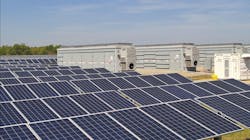RES Builds Battery Energy Storage System for Virginia’s Dominion
RES successfully completed the Scott battery energy storage system (BESS) pilot project in Virginia constructed on behalf of client, Dominion Energy.
The 12 MW/48 MWh project consists of three independent systems located at one site — an AC-coupled battery energy storage system and two DC-coupled battery energy storage systems retrofitted to an existing solar PV facility — the company’s first project of its kind in Virginia.
RES has delivered more than 22 GW of renewable energy projects across the globe and supports an operational asset portfolio exceeding 9GW worldwide for a large client base.
“The completion of this pilot project represents a milestone for RES and Dominion as it paves the way for additional energy storage projects needed to support a carbon free future,” said John Rohde, CEO of RES in the Americas.
“We are in the midst of a clean energy transition and this pilot project at Scott Solar is laying the foundation for a cleaner energy future,” said Ed Baine, President of Dominion Energy Virginia. “These battery storage systems will enable the company to better understand how best to deploy utility scale batteries across our service territory, support grid reliability, and ultimately enable the integration of more renewable generation resources.”
The AC-coupled BESS is a 10 MW, 4-hour system which seeks to align peak production with peak load demand. It is the first BESS in the country to utilize CATL battery cells and Dynapower components with RES’s RESolve EMS controller.
The two DC-coupled batteries are each an independent 1 MW, 4-hour system that are charged by capturing clipped energy (energy that would otherwise be lost when a solar panel’s output potential exceeds the amount of power an inverter can convert) directly from the existing solar panels.
This is the company’s first project of its kind in the United States and integrates the same technology into the existing inverters via custom-built recombiner boxes and reverse current mitigation devices specifically engineered and designed by RES, EVS and ConnectPV.
About the Author
T&D World Staff
Content Team
Nikki Chandler
Group Editorial Director, Energy
[email protected]
Jeff Postelwait
Managing Editor
[email protected]
Christina Marsh
Senior Editor
[email protected]
Ryan Baker
Associate Editor
[email protected]
Amy Fischbach
Electric Utility Operations
[email protected]
Rich Maxwell
Community Editor
[email protected]
Gene Wolf
Technical Editor
[email protected]
